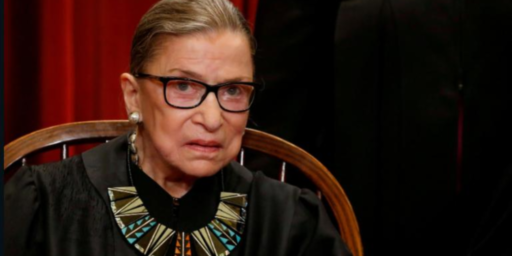Chief Justice William Rehnquist – Obituary
William H. Rehnquist, who served thirty two years on the U.S. Supreme Court, nineteen as Chief, has died after a long battle with cancer. As Stotch notes below, the obituaries are focusing mostly on the political implications.
Linda Greenhouse’s for the New York Times is no exception. Still, it does a creditable job taking at least the public measure of a very private man.
William H. Rehnquist, Chief Justice of Supreme Court, Is Dead at 80 [print]
William H. Rehnquist, who died Saturday at the age of 80 almost a year after learning he had thyroid cancer, helped lead a conservative revolution on the Supreme Court during 19 years as chief justice of the United States.
Chief Justice’s Rehnquist”s death came six weeks after he refuted rumors that he would soon retire by announcing that he intended to serve as long as his health permitted. At the time of that announcement, on July 14, photographers had been camped out for weeks outside his house in Arlington, Va.
Following his diagnoses of cancer last October, the chief justice was treated with chemotherapy and radiation and missed months of the court’s arguments. But he returned to the bench in March and participated actively in the court’s business, despite breathing and speaking through a hole that surgeons had cut in his throat.
Instead of the chief justice, it was Justice Sandra Day O’Connor who announced her retirement at the end of the court’s last term. President Bush named a former Rehnquist law clerk, Judge John G. Roberts Jr. of the federal appeals court here to succeed her, and confirmation hearings were set to begin on Tuesday.
Including 14 years as an associate justice, Chief Justice Rehnquist’s tenure on the court was not only one of the longest in the institution’s history but also one of the most consequential. With a steady hand, a focus and commitment that never wavered, and the muscular use of the power of judicial review, he managed to translate many of his long-held views into binding national precedent.
Chief among those was an enhanced role for the states within the federal system, which the court accomplished under his leadership by overturning dozens of federal laws that sought to project federal authority into what the Supreme Court majority viewed as the domain of the states.
In the zero-sum game of the tri-partite separation of powers, the Supreme Court’s own power grew correspondingly as the justices circumscribed the power of Congress. The court’s institutional enhancement was an irony of Chief Justice Rehnquist’s tenure, because another goal that he accomplished in large measure was to shrink the role of the federal courts by taking them out of the business of running prisons, school systems and other institutions of government.
The Rehnquist years included one historic episode of galvanizing drama and deep divisiveness, the decision in Bush v. Gore that decided the 2000 presidential election by ending the recount in Florida and handing a wafer-thin victory to George W. Bush. While Chief Justice Rehnquist voted with the 5 to 4 majority, his central role in the case was largely behind the scenes and the controlling opinion did not carry his name.
While Chief Justice Rehnquist was a self-confident and not unduly modest man, that near-invisibility was itself quite characteristic and led many people to assume incorrectly that one of his flashier colleagues, Justice Antonin Scalia, had played the stage-manager’s role in the events that resulted in the final decision in Bush v. Gore.
“Rehnquist is the opposite of Scalia,” Professor Robert C. Post of the law school at the University of California at Berkeley said in an interview. “Rehnquist doesn’t particularly want to be noticed. He’s not interested in getting credit. He’s just interested in getting the job done.”
Chief Justice Rehnquist also had the unusual experience of presiding over a presidential impeachment trial, a role ordained for the chief justice by the Constitution. During the five weeks in early 1999 that it took the Senate to try and acquit President Bill Clinton on charges of perjury and obstruction of justice, the chief justice was an unfamiliar presence in the Senate chamber, occasionally moving the proceedings along but having little of substance to do. “I did nothing in particular and I did it very well,” he told a television interviewer, Charlie Rose, two years later, borrowing a line from one of his favorite Gilbert and Sullivan operettas, “Iolanthe.”
[…]
At six feet three inches, and often stooped due to back pain, he was rather ungainly. A flat Midwestern accent revealed his Wisconsin childhood, although he left the Midwest for military service in World War II at the age of 19 and never returned there to live. His adopted home state was Arizona.
He loved amateur theatricals, led his law clerks in sing-alongs, and would bet with his fellow justices over anything, including the depth of snow on the marble plaza outside the court. He answered a contest in The Washington Post, which asked readers to figure out what make of car was referred to by the license place 1 DIV 0. “I believe it refers to an Infiniti, since when you divide 0 into 1, the result is infinity,” he wrote in his winning answer.
He wrote books on Supreme Court history as well as an unpublished murder mystery set in the Justice Department. Asked by Brian Lamb of C-Span, in a 1998 interview, why he liked to write books, he replied: “It’s very nice to be able to write something you don’t have to get four other people to agree with before it can become authoritative.”
The man clearly had a sense of humor. Greenhouse’s piece does a solid job of encapsulating his political and judicial philosophies and thus only indirectly quite a bit about the man himself. He was, by all accounts, a very good one.
The piece also contains a javascript link to a video entitled, “The Legacy of Supreme Court Justice William Rehnquist.”
Elsewhere:
- Chief Justice William H. Rehnquist Dies (WaPo, A1)
Chief Justice Rehnquist has died (CNN)
Chief Justice William Rehnquist dies at 80 (MSNBC)
Supreme Court Chief Justice Rehnquist Dies (NYT-AP)
Chief Justice Rehnquist Dies of Cancer (LAT-AP)
Michelle Malkin has a superb roundup of blogger reactions, including the news that Alan Derschowitz called Rehnquist “a Republican thug” on Hannity and Colmes. Nice.
Reactions not covered by Malkin:
- Steven Taylor: “Even though it was clearly inevitable, I was a little shocked to see this headline this morning.”
Dan Drezner: “[W]hile there will undoubtedly be a focus on Rehnquist’s ideology as a justice, his greatest legacy for the Court might be his management skills — he was a vast improvement over both Burger and Warren in that capacity.”
Julian Sanchez: “Let the battle begin.”
Jeff Jarvis: “On FoxNews right now, Susan Estrich is saying that Katrina changes the landscape: Bush is weakened and he will be under new pressure to appoint a minority to the court.”
Chris Lawrence: “One hopes that both sides will resist the urge to further escalate the conflict over the court’s composition.” One hopes in vain, methinks.
Jeralyn Merritt notes an interesting parallelism: “The last time there were double vacancies at the Supreme Court was 1971. Nixon appointed Lewis Powell and William Rehnquist to fill them.”
Kevin Drum merely passes on the news, but his commentators go to town.
Finally, Jan Haugland probably speaks for all of us when he writes, “I wished this late summer contained somewhat fewer newsworthy events.”



